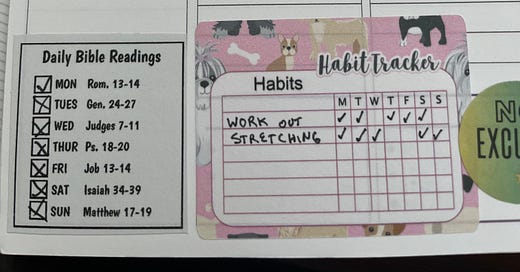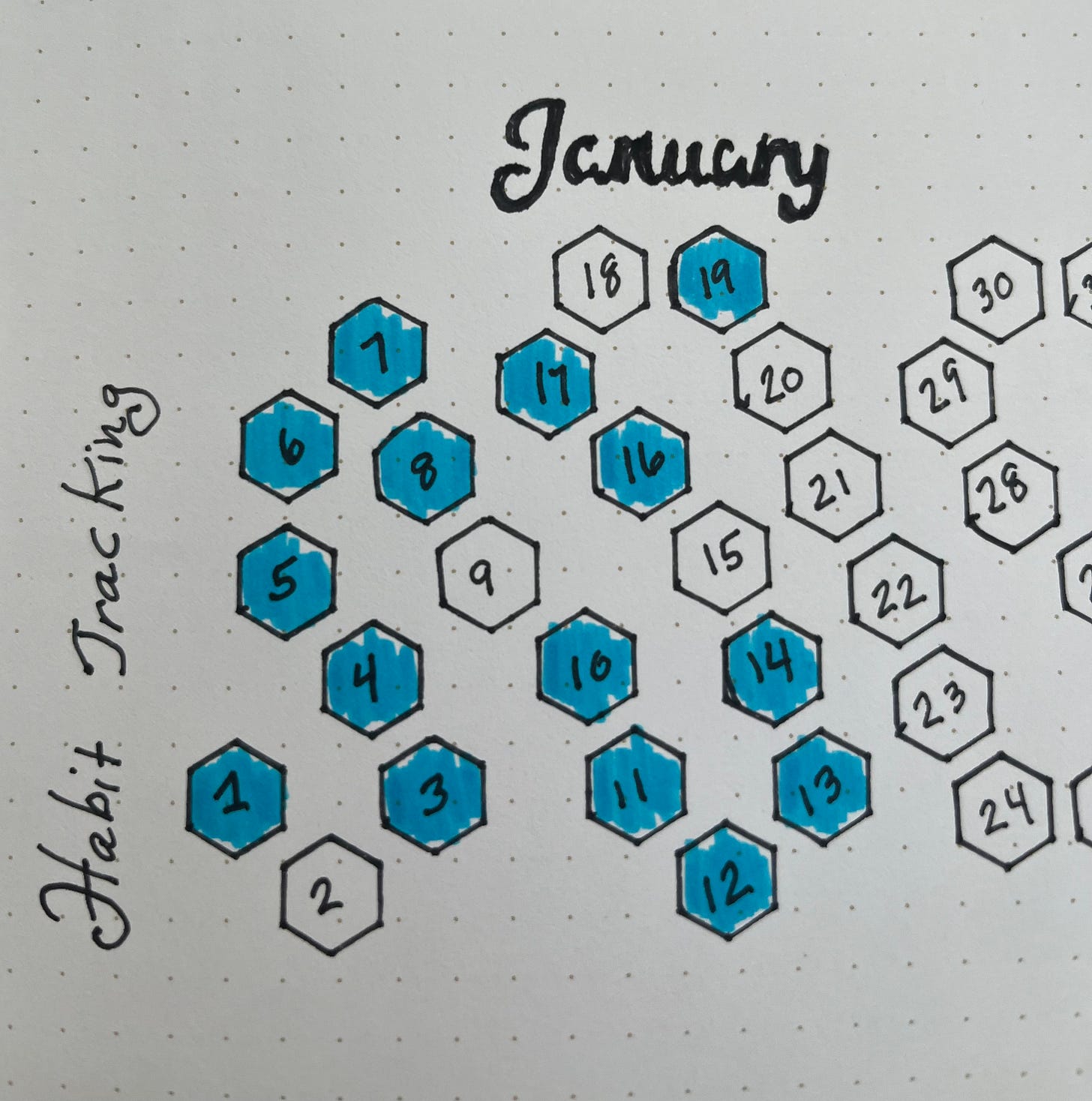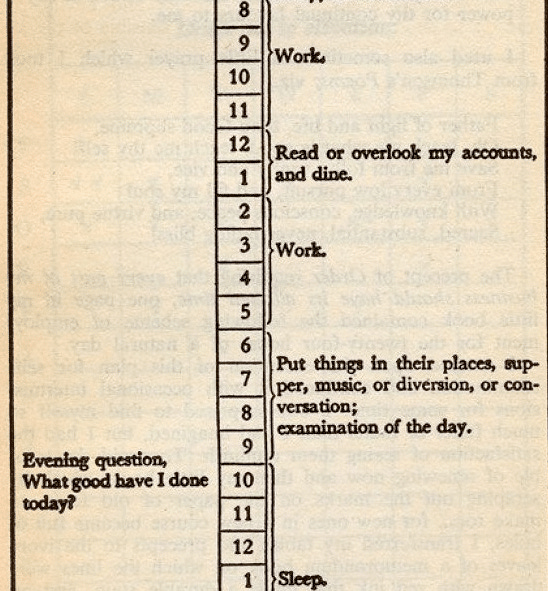Habit Trackers
Habit trackers are a form of self-discipline that gives a little bit of instant and recurring gratification to acheiving a long term goal. Why do we need the instant gratification? Well, if I answered because we are human, that would be a little too simple… however true. Goals often take a while to achieve, of course. In many cases, there is a long time before any appreciable results are actually seen. When we habit track, we get the little dopamine boost of being able to see something happen. What happens? Well, we check that box on our planner! What a satisfying sight to see. Continually ticking the box in the habit tracker encourages the continued desired behavior required to achieve the ultimate goal.
Habit tracking works for many people because the satisfaction of “box checking” (or coloring in shapes, as seen above) gives a subtle bit of pleasure. It provides with a visual or proof that something has occurred. However, this may not be enough for some people or for some habits that one may want to change. Let’s be honest and admit some habits are harder to break than others.
That’s where the concept of “precommitment” may be helpful.
Check! Feel that dopamine rush? No? Let’s move on to the next topic then.
Precommitment
Precommitment is a technique used to bolster ones own self-control or willpower. It often involves enlisting others to help, whether overtly or subvertly. Another version of precommitment can involve a carrot or stick approach. All of these precommitment approaches seek to bolster one’s own willpower with the willpower of others or other motivations, such as earning rewards or garnering penalties.
Overt Enlistment of Others
An overt enlistment of others in precommitment looks a little like this. Suzy wants to give up smoking. She gives all of her cigarettes to her roommate Sally, and says to Sally, “Right now I smoke 60 cigarettes a day. I want to quit smoking in 60 days. Every day give me one less cigarette each day starting with 59 and on down to 0.” Suzy has overtly enlisted her friend to actively help her in reaching her goal. She is relying heavily on her friend’s willpower to achieve her goal.
Another version of this hybridizes enlistment of others with a reward system or penalty system. More on this later.
Covert or Subversive Enlistment of Others
The way this is done subversively or covertly enlisting others to acheive a goal looks a little like this. Suzy wants to give up smoking. Suzy announces to Sally her roommate, and maybe even some others, that she will give up smoking completely in two months by smoking less each day. This is making the goal public, so that if the time passes and the goal has not been achieved then the goal setter, in this case Suzy, has to deal with the friends passing judgment on her for not achieving her stated goal. Or, at the very least they make jokes at her expense. Or whatever. I would argue that this is a pretty ineffective method, and would strongly discourage anyone to use this method to reach a stated goal. Why? Well, a lot of this depends on Suzy’s friends. Maybe they don’t care that much whether she quits or not. Maybe they actually want her to keep smoking. No matter how much they may care about Suzy’s goal, they also have their own things going on in their own life, and are unlikely to “mark their calendars” to ensure Suzy meets her 60 day deadline.
Another version of this involves making a bet with someone else. Suzy says to Sally, “If I don’t quit smoking in 60 days, then you pay me $100, if I do make it happen then I will give you $100!” This may work a little bit better because now the other party has an incentive to see you achieve the goal. This would not be my approach to goal achievement, but if it works for some folks then I am glad for them.
Penalty/Rewards Approach (Carrot or Stick)
There are two ways to impose a penalty on yourself if you do not complete the self-improvement activity for a given day. A price pact adds an accountability partner who enforces a penalty when mistakes are made during goal pursuit; a self-oriented price pact uses a self-imposed penalty. The system incentivizes sticking to the goal to keep from being penalized. Sally may say to Suzy, her roommate, “Each day over the next 60 days I am going to smoke one less cigarette per day. Every time I smoke more cigarettes then I allot for myself over the next 60 days, you add ten dollars to my share of the rent per each extra cigarette.” That is essentially what a “price pact” looks like, and it can be pretty effective. A self-imposed version of this is to donate or offload items if you break your rule. So, if Suzy smokes more than her day’s allotted amount of cigarettes, then she has to donate an item of clothing in her closet to charity. These are just some examples, but you understand the basic concept here - if you do not do the self-improvement activity then there is a penalty. Thats the stick.
The carrot or the awards approach involves getting an award if you complete the desired activity for the day. This can enlist the help of another or be self-imposed, as well. Suzy can say to Sally, “Sally, here is $300. Every ten days that I meet my commitment to smoking less each day, give me $50 of it back. If after the 60 days there is any of the $300 leftover, then I will donate that amount to charity.” So in this instance, Suzy is working for the reward of getting her money back. However, there is a little bit of a penalty aspect as well, with remaining monies going to charity and not back to Suzy. Suzy can also put 60 five dollar bills into a jar, and every day that she meets her commitment she gets to take $5 out and keep it. Again, this is just a basic example, but there are many ways to carry this out.
One literary example of using the precommitment of others takes place in the mythical Greek story of Ulysses (sometimes called Odysseus) and the Sirens, as described by Homer in The Odyssey. Jon Elster, the Norwegian philosopher refers to precommitment as "the Ulysses problem." The Sirens were beautiful maidens who lured sailors to their deaths with their ethereal singing. Ulysses, who was warned not to listen to the song of the Sirens, instructs his sailors to bind him to the mast of his ship and block their own ears before sailing past the island of the Sirens whose enchanting song draws sailors to shipwreck against the rocks. As he commands,
you must bind me with tight chafing ropes so I cannot move a muscle, bound to the spot, erect at the mast-block, lashed by ropes to the mast. And if I plead, commanding you to set me free, then lash me faster, rope on pressing rope.
Ulysses knew his own weakness of willpower, and he guards against his weakness to temptation by overtly enlisting others to bolster his own will. This is known as a Ulysses pact.
So what does all of this have to do with Ben Franklin???
Benjamin Franklin and his Thirteen Virtues
Ben Franklin, our highly inventive and remarkable Founding Father, may have invented the daily planner - pictured above is a page from his journal.
He also devised a method of tracking virtues, 13 to be exact. Why 13? Well there are 52 weeks in a year. Every week, Ben would chose one of the 13 virtues to focus on the most, and every 13 weeks he would start the list all over again, thereby completing four weeks per year to focus on each virtue.
Here is the list, as quoted from this website about Ben’s virtues:
So, in 1726, when he was only twenty years old, Franklin created a system that he believed would help him develop his character. Here are Benjamin Franklin’s thirteen virtues as he described them in his Autobiography:
Temperance: Eat not to dullness. Drink not to elevation.
Silence: Speak not but what may benefit others or yourself. Avoid trifling conversation.
Order: Let all your things have their places. Let each part of your business have its time.
Resolution: Resolve to perform what you ought. Perform without fail what you resolve.
Frugality: Make no expense but to do good to others or yourself: i.e., Waste nothing.
Industry: Lose no time. Be always employed in something useful. Cut off all unnecessary actions.
Sincerity: Use no hurtful deceit. Think innocently and justly; and if you speak, speak accordingly.
Justice: Wrong none by doing injuries, or omitting the benefits that are your duty.
Moderation: Avoid extremes. Forbear resenting injuries so much as you think they deserve.
Cleanliness: Tolerate no uncleanness in body, clothes, or habitation.
Tranquility: Be not disturbed at trifles, or at accidents common or unavoidable.
Chastity: Rarely use venery but for health or offspring; never to dullness, weakness, or the injury of your own or another’s peace or reputation.
Humility: Imitate Jesus and Socrates.
Here is an example of Franklin’s habit tracker:
Now we can debate whether or not Ben Franklin’s virtue tracking actually worked out for him since he was a known adulterer throughout his life and he was a known member of the infamous Hellfire Club. However, that really isn’t the focus of this here little blog, so you can read about that on your own. I am left asking, though, if our Founder, Mr. Franklin, should have followed the example of the Greek hero Ulysses and used precommitment in some form. What do you think? Take my (fun) poll below, and I would love to see your comments below!
Well, thats about all on this topic for now, but I plan to write in the near future about self-control. In an upcoming post, I will describe the difference between temperance and self-control. I also want to get into the marshmallow test and the concept of ego-depletion.
I am also planning to write more practical strategies for how to fit self-care into your routine and planning without being too overwhelming. That will be coming soon.
Stay tuned for more, and as always…
Thank you for reading.











The marshmallow test sounds intriguing!